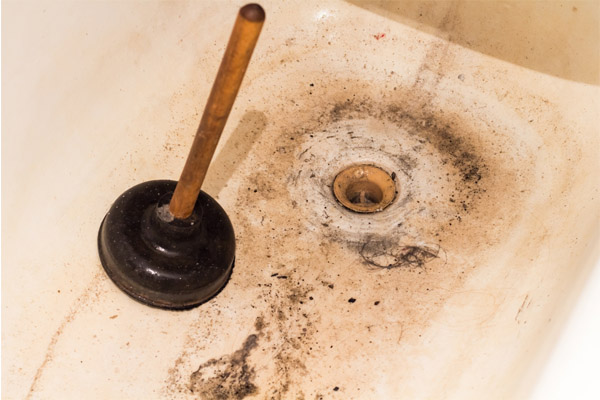Identifying the Causes of Effluent in the Bathtub
Identifying the Causes of Effluent in the Bathtub
Blog Article
They are making a few great pointers related to Why is There Sewage Coming Up Through the Bathtub as a whole in this post beneath.

Sewage back-up in the tub can be a traumatic and unhygienic issue for any home owner. Not only is it bothersome, but it also presents serious health risks and shows underlying problems with the plumbing system. Comprehending why sewer is turning up via the bath tub is critical for taking suitable activity to resolve the problem properly.
Intro to the Issue
Typical Factors for Sewer Back-up
Clogs in the Drain Line
Among one of the most typical root causes of sewer back-up is a clog in the sewer line. This can occur as a result of the build-up of debris, oil, or foreign items in the pipes, protecting against appropriate flow and creating sewage to back up right into your bath tub.
Tree Root Breach
Tree origins seeking dampness and nutrients can infiltrate drain lines with little splits or joints. Gradually, these roots can expand and increase, triggering considerable damages to the pipelines and causing sewer back-up problems.
Comprehending the Issue
When sewage starts backing up into the bathtub, it's a clear indication of a problem with the drainage system. The wastewater that ought to be moving away from your home is rather finding its back into your space, which can result in considerable damage and carcinogen.
Potential Reasons
Numerous factors can add to sewer back-up in the tub. From obstructions in the drain line to issues with the plumbing infrastructure, recognizing the source is vital for finding a remedy.
Aging Framework
Older homes might have dated plumbing systems that are much more prone to corrosion, cracks, and degeneration. As pipes age, they come to be much more vulnerable to leakages and obstructions, increasing the chance of sewage backup cases.
Heavy Rainfall or Flooding
Throughout durations of heavy rainfall or flooding, the sewer system may end up being overwhelmed with excess water, triggering backups and overflows. This can lead to sewage supporting into bath tubs and other components inside the home.
Signs of Sewage Back-up
Foul Odors
Unpleasant odors emanating from drains pipes or fixtures, particularly in the restroom, might suggest sewage backup problems. These smells are often solid and consistent, signaling a trouble that requires prompt interest.
Slow Draining Fixtures
Bathtubs, sinks, and toilets that drain pipes gradually or otherwise whatsoever could be experiencing sewage backup. If several fixtures are affected at the same time, it's likely that the problem originates from an usual factor, such as the main drain line.
Gurgling Sounds
Strange gurgling or bubbling noises coming from drains pipes when water is running elsewhere in the house are a sign of air caught in the plumbing system. This air accumulation can result from sewage back-up and ought to be explored promptly.
Wellness Dangers Connected With Sewer Backup
Contamination of Supply Of Water
Sewer backup can contaminate the water supply in your home, posing a serious wellness threat to you and your family members. Exposure to infected water can bring about intestinal issues, skin infections, and other ailments.
Mold and mildew Growth
Dampness from sewer back-up can create excellent problems for mold and mildew growth in your house. Mold and mildew spores can worsen breathing problems and trigger allergies in delicate individuals, making punctual cleaning essential.
Spread of Condition
Sewage consists of damaging germs, infections, and parasites that can trigger a variety of conditions, consisting of liver disease, cholera, and gastroenteritis. Coming into contact with sewage or infected surfaces puts you at risk of infection.
Tidying up After Sewage Backup
Sanitation Procedures
Extensively sanitize and sterilize influenced areas after sewer back-up to eliminate hazardous microorganisms and stop mold and mildew growth. Use proper cleansing items and safety equipment to guarantee secure and efficient clean-up.
Remediation of Impacted Areas
Repair any type of damage to floor covering, wall surfaces, or components brought on by sewage back-up. Depending on the degree of the damage, you may need to change carpets, drywall, or various other products to recover your home to its pre-loss problem.
Immediate Actions to Take
Switching Off Water
In case of sewer back-up, it's necessary to shut off the supply of water to prevent further contamination and damages. Find the primary water shutoff valve in your house and shut it off up until the problem can be fixed.
Contacting an Expert Plumber
Managing sewer backup is not a do it yourself job. Call a licensed plumber with experience in taking care of sewage-related problems to assess the scenario and carry out essential repairs or clean-ups.
Staying Clear Of Contact with Infected Water
Until the sewage backup is solved, stay clear of contact with contaminated water to avoid the spread of bacteria and microorganisms. Use protective gear if you should be in the damaged location and wash your hands thoroughly afterward.
Preventive Measures
Normal Maintenance of Sewer Lines
Set up routine assessments and upkeep of your sewage system lines to determine and deal with possible issues prior to they escalate into major troubles. This can consist of cleaning out debris, examining for tree root invasion, and repairing any kind of damaged pipes.
Setting Up Backwater Shutoffs
Consider mounting bayou valves in your plumbing system to stop sewage from flowing back right into your home throughout periods of heavy rainfall or flooding. These valves automatically close when water draws back up, shielding your property from contamination.
Appropriate Disposal of Household Waste
Avoid purging anything other than toilet paper and human waste down the commode to prevent clogs and clogs in the sewer line. Dispose of oil, oil, and other family chemicals effectively to decrease the threat of plumbing issues.
Why Is Water Backing Up in My Bathtub When I Flush My Toilet?
What to do about a sewer line clog
First, don’t bother with plunging. No amount of plunging will dislodge the clog in a sewer line. The clog is too far away. Plungers are for clogs in the toilet itself, not the sewer line. Plus, the most likely causes of a sewer clog are:
Tree roots Flushed toys or feminine products Grease buildup Those items don’t move easily. And in the case of tree roots, the roots need to be cut out of the pipe and the pipe will need to be repaired.
You’ll need a closet auger. A closet auger is a type of plumber’s snake with a protective cover to keep from scratching the delicate porcelain toilet. If the clog is further down, you may need to remove the toilet or use one of your cleanouts to get to the clog.
We also recommend doing a video inspection of the drain to ensure that the cause of the clog has been completely removed. Otherwise, you could have the same problem again in a few days or weeks.
https://mspplumbingheatingair.com/blog/why-is-water-backing-up-in-my-bathtub-when-i-flush-my-toilet

I'm just very curious about Why is Sewage Backing Up Into My Bathtub? and I really hope you appreciated my article. Loved our blog entry? Please quickly share it. Let others locate it. I cherish your readership.
Call Today
Report this page